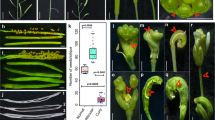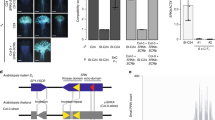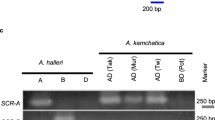Abstract
A diploid organism has two copies of each gene, one inherited from each parent. The expression of two inherited alleles is sometimes biased by the effects known as dominant/recessive relationships, which determine the final phenotype of the organism. To explore the mechanisms underlying these relationships, we have examined the monoallelic expression of S-locus protein 11 genes (SP11), which encode the male determinants of self-incompatibility in Brassica. We previously reported that SP11 expression was monoallelic in some S heterozygotes, and that the promoter regions of recessive SP11 alleles were specifically methylated in the anther tapetum1,2,3. Here we show that this methylation is controlled by trans-acting small non-coding RNA (sRNA). We identified inverted genomic sequences that were similar to the recessive SP11 promoters in the flanking regions of dominant SP11 alleles. These sequences were specifically expressed in the anther tapetum and processed into 24-nucleotide sRNA, named SP11 methylation inducer (Smi). Introduction of the Smi genomic region into the recessive S homozygotes triggered the methylation of the promoter of recessive SP11 alleles and repressed their transcription. This is an example showing sRNA encoded in the flanking region of a dominant allele acts in trans to induce transcriptional silencing of the recessive allele. Our finding may provide new insights into the widespread monoallelic gene expression systems.
This is a preview of subscription content, access via your institution
Access options
Subscribe to this journal
Receive 51 print issues and online access
$199.00 per year
only $3.90 per issue
Buy this article
- Purchase on Springer Link
- Instant access to full article PDF
Prices may be subject to local taxes which are calculated during checkout



Similar content being viewed by others
Accession codes
Primary accessions
GenBank/EMBL/DDBJ
Data deposits
Sequence data have been deposited in GenBank under accession numbers GQ473178–GQ473187 and GQ847769.
References
Shiba, H. et al. Dominance relationships between self-incompatibility alleles controlled by DNA methylation. Nature Genet. 38, 297–299 (2006)
Shiba, H. et al. The dominance of alleles controlling self-incompatibility in Brassica pollen is regulated at the RNA level. Plant Cell 14, 491–504 (2002)
Kakizaki, T. et al. Linear dominance relationship among four class-II S haplotypes in pollen is determined by the expression of SP11 in Brassica self-incompatibility. Plant Cell Physiol. 44, 70–75 (2003)
Darwin, C. The Effects of Cross and Self Fertilisation in the Vegetable Kingdom (Murray, 1876)
Suzuki, G. et al. Genomic organization of the S locus: identification and characterization of genes in SLG/SRK region of S9 haplotype of Brassica campestris (syn. rapa). Genetics 153, 391–400 (1999)
Schopfer, C. R., Nasrallah, M. E. & Nasrallah, J. B. The male determinant of self-incompatibility in Brassica. Science 286, 1697–1700 (1999)
Takayama, S. et al. The pollen determinant of self-incompatibility in Brassica campestris. Proc. Natl Acad. Sci. USA 97, 1920–1925 (2000)
Stein, J. C., Howlett, B., Boyes, D. C., Nasrallah, M. E. & Nasrallah, J. B. Molecular cloning of a putative receptor protein kinase gene encoded at the self-incompatibility locus of Brassica oleracea. Proc. Natl Acad. Sci. USA 88, 8816–8820 (1991)
Takasaki, T. et al. The S receptor kinase determines self-incompatibility in Brassica stigma. Nature 403, 913–916 (2000)
Kachroo, A., Schopfer, C. R., Nasrallah, M. E. & Nasrallah, J. B. Allele-specific receptor-ligand interactions in Brassica self-incompatibility. Science 293, 1824–1826 (2001)
Takayama, S. et al. Direct ligand–receptor complex interaction controls Brassica self-incompatibility. Nature 413, 534–538 (2001)
Nasrallah, J. B. & Nasrallah, M. E. Pollen–stigma signaling in the sporophytic self-incompatibility response. Plant Cell 5, 1325–1335 (1993)
Hatakeyama, K., Watanabe, M., Takasaki, T., Ojima, K. & Hinata, K. Dominance relationships between S-alleles in self-incompatible Brassica campestris L. Heredity 80, 241–247 (1998)
Carthew, R. W. & Sontheimer, E. J. Origins and mechanisms of miRNAs and siRNAs. Cell 136, 642–655 (2009)
Voinnet, O. Origin, biogenesis, and activity of plant microRNAs. Cell 136, 669–687 (2009)
Shiba, H. et al. A pollen coat protein, SP11/SCR, determines the pollen S-specificity in the self-incompatibility of Brassica species. Plant Physiol. 125, 2095–2103 (2001)
Shiba, H. et al. Genomic organization of the S-locus region of Brassica. Biosci. Biotechnol. Biochem. 67, 622–626 (2003)
Casselman, A. L. et al. Determining the physical limits of the Brassica S locus by recombinational analysis. Plant Cell 12, 23–33 (2000)
Franco-Zorrilla, J. M. et al. Target mimicry provides a new mechanism for regulation of microRNA activity. Nature Genet. 39, 1033–1037 (2007)
Shiba, H. et al. Alteration of the self-incompatibility phenotype in Brassica by transformation of the antisense SLG gene. Biosci. Biotechnol. Biochem. 64, 1016–1024 (2000)
Khraiwesh, B. et al. Transcriptional control of gene expression by microRNAs. Cell 140, 111–122 (2010)
Alleman, M. et al. An RNA-dependent RNA polymerase is required for paramutation in maize. Nature 442, 295–298 (2006)
Erhard, K. F., Jr et al. RNA polymerase IV functions in paramutation in Zea mays. Science 323, 1201–1205 (2009)
Stam, M., Belele, C., Dorweiler, J. E. & Chandler, V. L. Differential chromatin structure within a tandem array 100 kb upstream of the maize b1 locus is associated with paramutation. Genes Dev. 16, 1906–1918 (2002)
Hale, C. J., Stonaker, J. L., Gross, S. M. & Hollick, J. B. A novel Snf2 protein maintains trans-generational regulatory states established by paramutation in maize. PLoS Biol. 5, e275 (2007)
Law, J. A. & Jacobsen, S. E. Establishing, maintaining and modifying DNA methylation patterns in plants and animals. Nature Rev. Genet. 11, 204–220 (2010)
Kakizaki, T. et al. Comparative analysis of the S-intergenic region in class-II S haplotypes of self-incompatible Brassica rapa (syn. campestris). Genes Genet. Syst. 81, 63–67 (2006)
Guo, M. et al. Allelic variation of gene expression in maize hybrids. Plant Cell 16, 1707–1716 (2004)
Wang, J., Valo, Z., Smith, D. & Singer-Sam, J. Monoallelic expression of multiple genes in the CNS. PLoS ONE 2, e1293 (2007)
Milani, L. et al. Allele-specific gene expression patterns in primary leukemic cells reveal regulation of gene expression by CpG site methylation. Genome Res. 19, 1–11 (2009)
Bao, N., Lye, K. W. & Barton, M. K. MicroRNA binding sites in Arabidopsis class III HD-ZIP mRNAs are required for methylation of the template chromosome. Dev. Cell 7, 653–662 (2004)
Acknowledgements
We thank Q. A. Ngo and P. Kaothien-Nakayama for critical comments and discussion; K. Nakashima for helpful comments; and H. Ichikawa, T. Ohnishi, F. Yamamoto, M. Kawashima and R. Nagai for technical assistance. This work was supported by the Program for Promotion of Basic Research Activities for Innovative Biosciences (to S.T.) from the Bio-oriented Technology Research Advancement Institution (BRAIN), by Grants-in-Aid for Creative Scientific Research (to A.I., M.W. and S.T.) from the Japan Society for the Promotion of Science (JSPS), and by Grants-in-Aid for Scientific Research on Priority Area (to H.S., M.W. and S.T.) and Grants-in-Aid for the Global Center of Excellence Program to NAIST from the Ministry of Education, Culture, Sports, Science and Technology (MEXT).
Author information
Authors and Affiliations
Contributions
Y.T. designed and performed the experiments, and wrote the paper. H.S., A.I. and S.T. initiated the study, provided advice regarding the experiments, and wrote the paper. M.I. performed the in situ hybridization. T.K., G.S. and M.W. provided plant materials and performed the sequence analyses of the S locus.
Corresponding author
Ethics declarations
Competing interests
The authors declare no competing financial interests.
Supplementary information
Supplementary Information
This file contains Supplementary Figures 1-8 with legends and Supplementary Tables 1-5. (PDF 9594 kb)
Rights and permissions
About this article
Cite this article
Tarutani, Y., Shiba, H., Iwano, M. et al. Trans-acting small RNA determines dominance relationships in Brassica self-incompatibility. Nature 466, 983–986 (2010). https://doi.org/10.1038/nature09308
Received:
Accepted:
Issue Date:
DOI: https://doi.org/10.1038/nature09308
This article is cited by
-
Dominance in self-compatibility between subgenomes of allopolyploid Arabidopsis kamchatica shown by transgenic restoration of self-incompatibility
Nature Communications (2023)
-
MLPK function is not required for self-incompatibility in the S29 haplotype of Brassica rapa L.
Plant Reproduction (2023)
-
Ancestral self-compatibility facilitates the establishment of allopolyploids in Brassicaceae
Plant Reproduction (2023)
-
On the origin of the widespread self-compatible allotetraploid Capsella bursa-pastoris (Brassicaceae)
Heredity (2021)
-
Beyond large-effect loci: large-scale GWAS reveals a mixed large-effect and polygenic architecture for age at maturity of Atlantic salmon
Genetics Selection Evolution (2020)
Comments
By submitting a comment you agree to abide by our Terms and Community Guidelines. If you find something abusive or that does not comply with our terms or guidelines please flag it as inappropriate.



